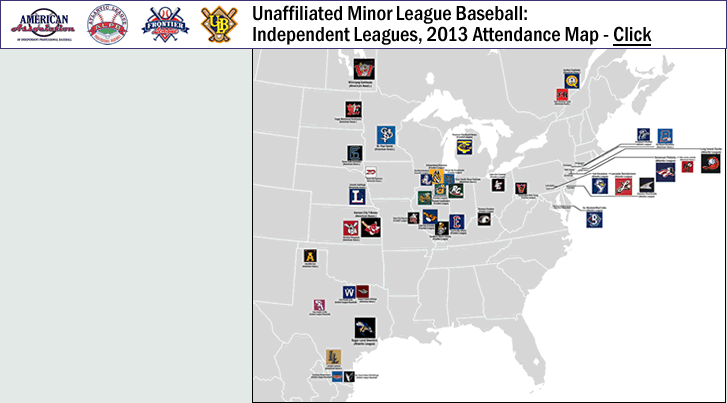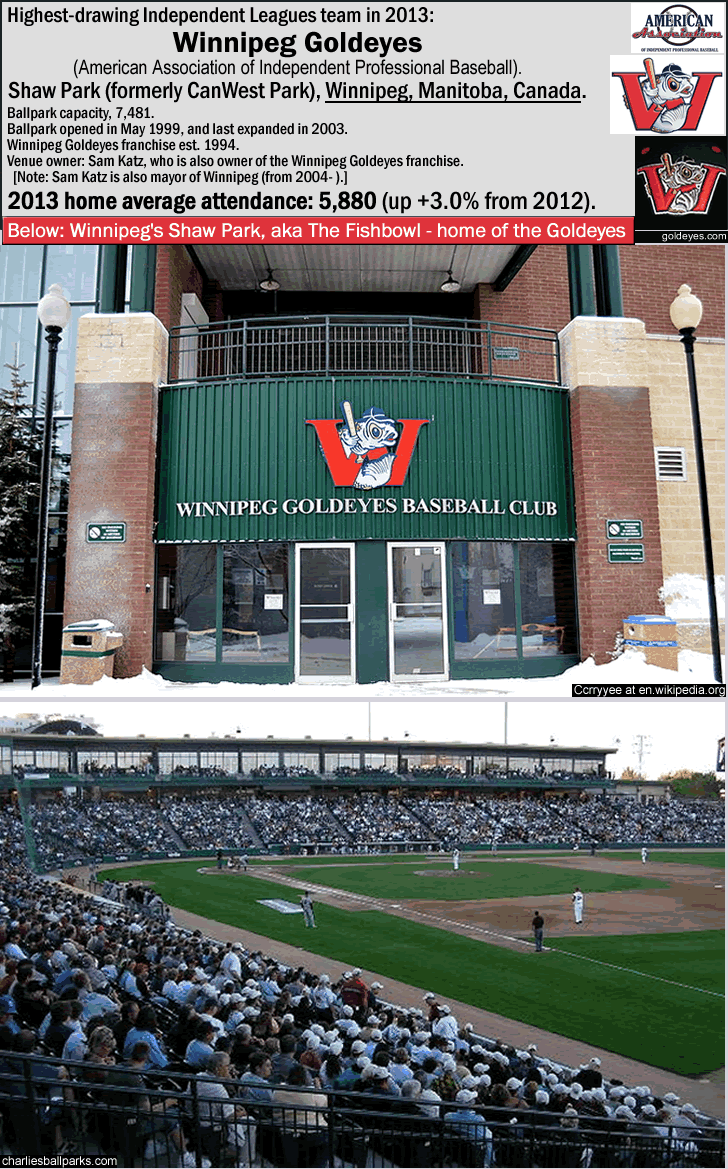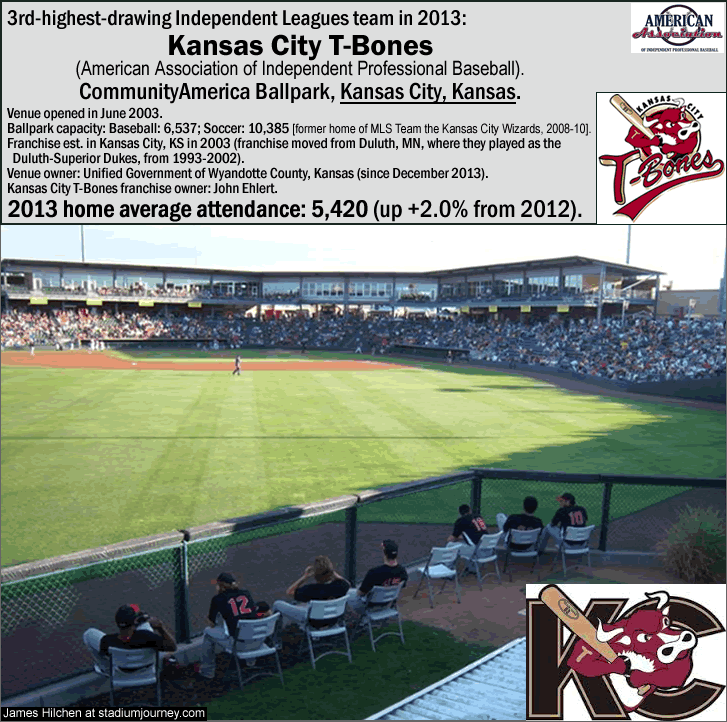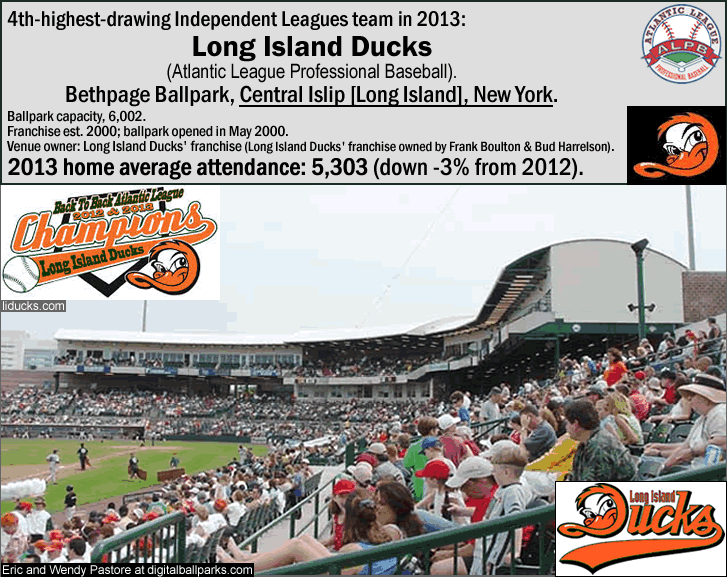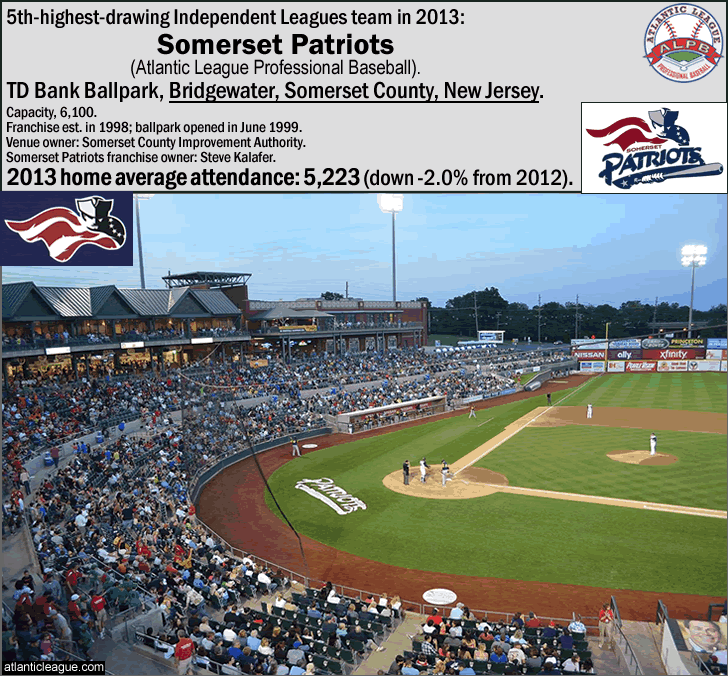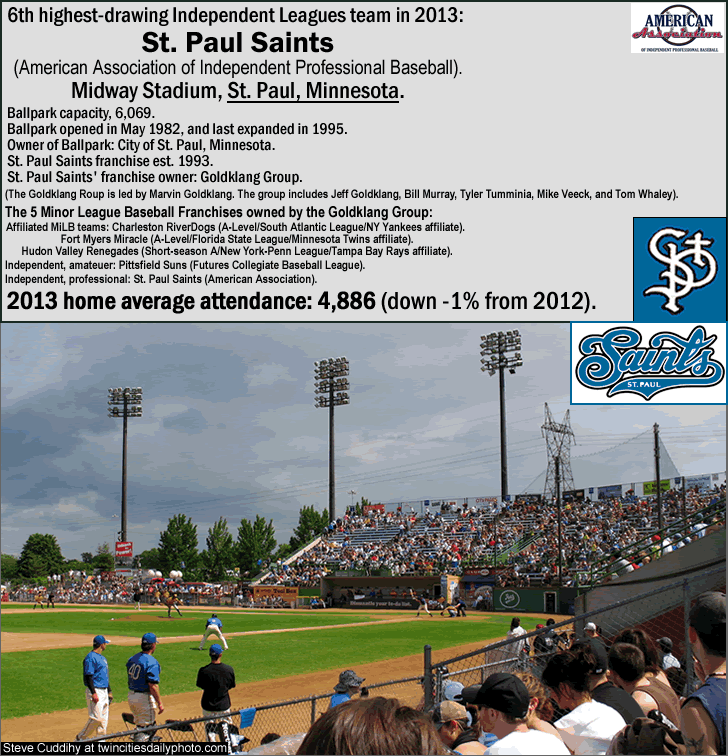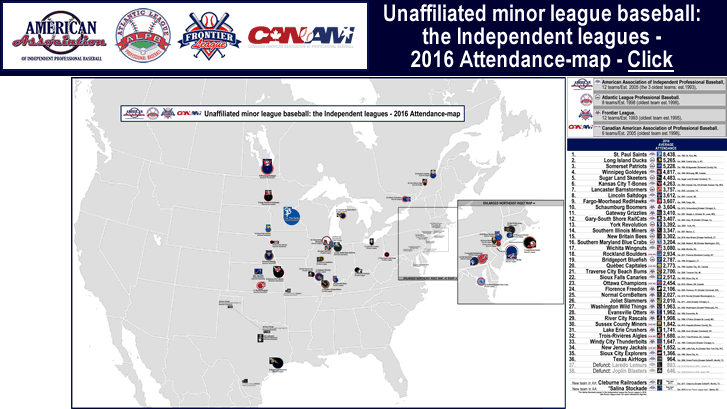
Independent leagues: 2016 attendance-map, 38 Independent leagues teams in USA & Canada (American Association, Atlantic League, Can-Am League, Frontier League)
…
…
By Bill Turianski on 23 April 2017; twitter.com/billsportsmaps.
Links…
-2016 Independent Attendance by Average (by Kevin Reichard on September 19, 2016 at ballparkdigest.com).
-Independent baseball league/Current_leagues (en.wikipedia.org).
-independentbaseball.net.
-twitter.com/independentball.
-
Major League Baseball, and by extension, Organized Baseball, has an antitrust exemption…
Organized Baseball is: the 30 Major League Baseball teams {2016 MLB paid-atttendance map}, plus all the 234 affiliated minor league baseball teams [aka MiLB teams], which the MLB teams co-fund and use as developmental teams for their rosters; plus the 16 unaffiliated Mexican League teams / {my latest map of the Mexican League}.
Independent leagues are, by definition, completely comprised of pro baseball teams which operate outside of Organized Baseball.
The Independent leagues are technically not even really minor leagues…but everybody considers them as such, and most observers within the world of pro baseball consider them to be equivalent to a caliber of play between Double-A and Advanced-A level minor league ball [ie, a caliber of skill between two and three levels below the Major Leagues]).
Major League Baseball (MLB) has antitrust exemption, dating back to a 1922 ruling that centered on the suit brought about by the owners of the defunct 1914 Federal League team the Baltimore Terrapins {see this article, Baseball’s Con Game – How did America’s pastime get an antitrust exemption?, from 2002 by David Greenberg at slate.com}. Basically, in 1922, the Supreme Court justices maintained – naively – that Major League Baseball is a game, not a business. Justice Oliver Wendell Holmes wrote that “personal effort, not related to production, is not a subject of commerce”. What? Personal effort (ie, major league baseball players competing against each other) sure is related to production…just look at all that ticket revenue that MLB produces. Just look at those lucrative television contracts that MLB gets. Where did all that revenue come from? It came from personal effort (major league baseball players competing against each other). As Kavitha Dividson remarked at Bloomberg.com, “Nine decades later, the notion that professional baseball wouldn’t be considered commerce seems rather quaint. Not only is the “personal effort” of Major Leaguers an $8 billion product in and of itself, the lucrative national broadcast deals and growing audience for online streaming clearly place a significant chunk of business operations across state lines. Professional baseball can no longer be considered a local business, if it really ever could have been.” {Quote from, Antitrust Exemption Holds Baseball Back a Century (by Kavitha Davidson on April 8 2014 at bloomberg.com).}
There are many ways that this antitrust exemption affects things in the world of pro baseball. One is how the Oakland A’s franchise continues to get screwed by MLB and the San Francisco Giants…because the SF franchise owns the territory of San Jose, and MLB and the Giants have succeeded – in courts – from preventing the A’s from moving to San Jose. {See this: U.S. Supreme Court rejects San Jose’s bid to lure Oakland A’s (by Bob Egelko from Oct. 2015 at sfgate.com).} One of the latest ways the MLB antitrust exemption affects people within Organized Baseball is this: MLB scouts maintaining that they are being exploited {see this, Scouts Tell 2nd Circ. MLB Antitrust Exemption Doesn’t Apply (by Zachary Zagger on Jan. 23 2017 at law360.com)}. But here, I am only going to talk about how MLB’s antitrust exemption has inadvertently led to the success of most of the highest-drawing Independent leagues teams.
-
Independent leagues (unaffiliated minor league baseball)…
Independent leagues have no affiliation with Major League Baseball – no player development contracts means the Independent leagues teams must pay for personnel and equipment. On the other hand, affiliated minor league teams have their WHOLE PAYROLL paid for them, by the Major League team…as it says in Wikipedia’s page on affiliated minor league baseball…“Generally, the parent major league club pays the salaries and benefits of uniformed personnel (players and coaches) and bats and balls, while the minor league club pays for in-season travel and other operational expenses…” (en.wikipedia.org/wiki/Minor League Baseball/Current system).
Independent leagues exist because MLB/Organized Baseball can actually ignore market forces…
There is essentially one reason why an Independent leagues team springs up in any given place. That is because the the ownership group in the municipality in question was unable to to secure an affiliated minor league team within Organized Baseball. With a few exceptions (the most prominent exception being the Sugar Land Skeeters of Greater Houston, TX), the highest-drawing of these Independent teams are located in the Upper Midwest and in the Northeast (and to a lesser extent, in Canada). Generally, here and there, in Organized Baseball, there are poorly-drawing teams within the affiliated leagues above the Short-Season-A and the Rookie levels (like two A-level teams in the Midwest League, in Burlington, Iowa and in Beloit, Wisconsin, both of whom draw below 1.2 K in a league which drew 3.8 overall in 2016). But the real dead weight with respect to bad drawing mid-and-upper-level-MiLB teams can be found in two warm-weather locales. You see, MLB/MiLB/Organized Baseball has two leagues that are, attendance-wise, real under-performers. Two leagues that are, to put it bluntly, a waste of space. I am speaking of two of the three Advanced-A-level leagues: the California League and the Florida State League. Year in, year out, these two leagues are chock full of teams that draw abysmally, especially since both regions have considerable populations. Last season [2016], 7 of the 10 California League teams drew below 2.5 K. And last season, 11 of the 12 Florida State League teams drew below the even lower bar of just 2.0 K. That is really bad attendance for a product that is just 3 levels below the Major Leagues. And this is happening in regions where hundreds and hundreds of thousands of people live nearby. Actually, most of those bad drawing teams in the California and Florida Advance-A-level leagues have over a million people within an hours’ drive. And they still draw poorly.
How pathetic is the attendance in the California League and Florida State League?
Look at it this way…
-California League overall average attendance in 2016 was 2.1 K…worse than 23 Independent leagues teams.
-Florida State League overall average attendance in 2016 was 1.3 K…worse than 34 Independent leagues teams.
{Source of figures in last two paragraphs: 2016 Affiliated Attendance by League (ballparkdigest.com).}
Meanwhile, there are municipalities all over the Upper Midwest and the Northeast that could EASILY maintain successful affiliated minor league teams. But for one legitimate reason (Spring training ballparks/facilities in Florida that are already there anyways), and one bogus reason (the hidebound notion that California deserves an affiliated minor league of its own), MLB/Organized Baseball – thanks to its antitrust exemption – can afford to ignore market forces. And ignore the fact that there are scores of minor league franchises which would have far better support…if they relocated out of Florida and California. And into Midwestern and Northeastern towns which are dying for affiliated minor league ball.
So, though ignored by Organized Baseball, Independent leagues teams, located in places off-the-beaten-track, thrive. Like in Winnipeg, Manitoba; and in Fargo, North Dakota; and in Lincoln, Nebraska; and in Marion, southern Illinois. And Independent leagues teams located very near to MLB franchises? They really thrive (see next 3 paragraphs). If the vast majority of the fine folks of Florida and California could not give a rat’s ass about a great and affordable product (affiliated minor league baseball), then why the heck don’t these dead-weight teams move to where people would appreciate such a great product? Successful Independent leagues teams prove that there are an abundance of locales which Organized Baseball has ignored, thanks to its de-facto-monopoly status. And don’t forget, these are Independent teams with basically no brand-name drawing-power. Yet they are outdrawing teams – affiliated minor league ball clubs – that are part of world-renowned brand-names (the Major League teams).
…
The positive side of no MLB affiliation…
The positive side of no MLB affiliation means Independent leagues franchises are not bound to abide by MLB’s onerous territorial mandates. Mandates which MLB/Organized Baseball can only enforce because of their antitrust exemption. For example, MLB allows no affiliated minor league baseball teams to be located in Nassau and Suffolk Counties, NY (ie, Long Island) [to protect the NY Mets]; as well as no other affiliated teams in southeast-central-Pennsylvania [to protect the Philadelphia Phillies as well as the affiliated minor league baseball teams the Reading Fightin Phils and the Harrisburg Senators]. So Independent leagues teams have sprung up in those 2 areas and have done very well drawing customers [the Long Island Ducks in Nassau County, New York; the York Revolution and the Lancaster Barnstormers in south-eastern Pennsylvania].
Basically, Organized Baseball usually does not put its affiliated minor league teams within the 75-mile-radius territory of the 30 MLB teams – with a few exceptions such as in: Tacoma, WA; Reading, PA; Toledo, OH; San Jose, CA; Tampa and Clearwater, FL; and, recently (in the last 20 years), in Dayton, OH; and in Bridgewater Township, NJ; and in Brooklyn, NY and in Staten Island, NY. But Independent leagues teams, again, can ignore MLB’s territorial edicts. Hence the (successful) Independent leagues teams such as…the St. Paul Saints of St. Paul, MN (right next to MLB’s Minnesota Twins); and the Kansas City T-Bones of Kansas City, KS (right next to MLB’s Kansas City Royals); and the Sugar Land Skeeters of Greater Houston, TX (right next to MLB’s Houston Astros); and the Somerset Patriots of Somerset County, NJ (relatively close by to MLB’s New York Yankees and New York Mets).
It is no coincidence that 5 of the 6 the top-drawing Independent teams would not be allowed to exist within Organized Baseball…
Five of the six highest-drawing Independent leagues teams (which all draw above 4-K-per-game) are located in places very near to MLB teams (ie, well within the 75-mile-radius protected areas [thanks to their antitrust exemption], which MLB/Organized Baseball can only enforce with respect to affiliated minor league teams):
1). St. Paul Saints: drawing 8.4 K/ St. Paul, MN [Minnesota Twins' territory].
2). Long Island Ducks: 5.2 K/ Nassau County, Long Island, NY [NY Mets' territory].
3). Somerset Patriots: 5.2 K/ Somerset County, NJ. [NY Yankees'/NY Mets' territory].
4). Winnipeg Goldeyes: 4.8 K/ Winnipeg, MB, Canada [no MLB team nearby].
5). Sugar Land Skeeters: 4.4 K/ Sugar Land, TX [Houston Astros' territory].
6). Kansas City T-Bones: 4.2 K/ Kansas City, KS [Kansas City Royals' territory].
The biggest problem Independent leagues teams face is overhead…
Again, Independent leagues teams get zero support from MLB/Organized Baseball, whereas affiliated minor league teams (being part of MLB/Organized Baseball) basically get their whole teams’ salaries (and some of their gear) paid for. So Independent leagues teams live a precarious financial existence, and are very prone to becoming defunct, and are almost completely reliant on ticket revenue and concessions to remain in business. In fact, last season [2016], the two lowest-drawing teams, of the four Independent leagues featured on the map here, both went out of business (Joplin and Laredo/see next section below). The following article from the Wall Street Journal explores just how precarious Independent baseball teams’ finances are…
-{How Independent Baseball Teams Make Money. Or Don’t. For unaffiliated teams, it takes gimmicks, cost cutting and a lot of luck (by Andrew Beaton on Aug. 24 2105 from wsj.com)}.
…
-
What the map-and-chart of Independent ball clubs shows…
The main map is of USA and Canada; the inset-map is of the Northeast of the US. The two maps show the 38 Independent leagues teams in the USA & Canada which reported attendances figures (from home regular season games) in 2016, and which drew over 500-per-game…plus 2 new teams (see next paragraph). The 500-per-game cut-off is why I did not include the 4 teams from the Pacific Association, whose 4 teams only drew between 437 and 69 per game. The fact that some Independent league do not report attendance figures is why the map-and-chart does not feature teams from 3 other Independent leagues…the Empire League, the Pecos League, and the United Shore League {for info on those leagues, see this, en.wikipedia.org/wiki/Independent_baseball_league#Current_leagues}. If you are wondering why those three Independent leagues don’t report attendance figures, well, it is almost certainly because those teams in those leagues do not draw very well.
On the map, two of the teams [from the American Association] are now defunct: the Joplin Blasters, and the Laredo Lemurs. It is no coincidence that those two teams happened to be the two worst-drawing teams in the 4 leagues that the map depicts. Because, as mentioned earlier, Independent leagues teams basically live or die by their attendance figures, that being their only real source of revenue. Those two teams have been replaced in the American Association by one expansion team and one team that has moved over from the aforementioned Pecos League. The brand-new franchise for 2017 is the Cleburne Railroaders of Greater Dallas/Ft. Worth, TX. The franchise that has jumped over from the Pecos League to the American Association is the Salina Stockade (of Salina, Kansas). And finally, there is one franchise, in the Atlantic League, that has been recently relocated – the New Britain Bees (est. 2016) [of Greater Hartford, CT], who were the Camden Riversharks previously, but moved from Camden, NJ [Greater Philadelphia, PA] to Connecticut after the 2015 season. Here is an example of an Independent team filling the gap left by the lack of an affiliated MiLB team, because New Britain, CT had a Double-A MiLB team (the New Britain Rock Cats), until that franchise moved 12 miles up the road to Hartford, as the Hartford YardGoats, in 2016 {here’s a Double-A [affiliated MiLB] map I made in 2016, which mentions the new Hartford ball club}. That Camden-NJ-to-New-Britain-CT-franchise-move is shown on the map-page in the inset-map of the Northeast US.
The teams on the map have their primary cap-logo shown, as well as a circle in their team-colors.
The team-color-circles are sized to depict each team’s drawing-power (the higher their average attendance is, the larger their team-colors-circle is).
At the right-hand side of the map page is a chart that lists 5 things:
A). Teams’ attendance-rank within Independent leagues baseball.
B). The Independent league which each team is in.
C). The teams’ 2016 average attendance…regular season home games/ source: 2016 Independent Attendance by Average (ballparkdigest.com).
D). Teams’ year-of-establishment [first season they played].
E). Teams’ City-and-State-location (plus County-location, if that is part of any given team’s name).
The teams on the map are from the following 4 Independent leagues…
-American Association [American Association of Independent Professional Baseball], all 12 teams, including 2 defunct teams (see 3 paragraphs above), and including 2 new teams: the Cleburne Railroaders (est. 2017) [of Greater Dallas/Ft. Worth, TX], and the Salina Stockade (est. 2016/former Pecos League team) [of Salina, KS]). (American Association est. 2006/ 12 teams in 2017/ range: Plains States (Dakotas to Texas); one team from Indiana; one team from Manitoba, Canada.) 2016 overall average attendance: 3,156.
-Atlantic League [Atlantic League Professional Baseball], all 8 teams (including the 2016-relocated-team the New Britain Bees [of Greater Hartford, CT]). (Atlantic League est. 1998/ 8 teams in 2017/ range: Northeast; and Greater Houston, Texas.) 2016 overall average attendance: 3,939 [best-drawing Independent league].
-Frontier League, all 12 teams. (Frontier League est. 1993/ 12 teams in 2017/ range: half the teams [6 teams] from Illinois; one team each from: Missouri, Indiana, Michigan, Ohio, Kentucky, western Pennsylvania.) 2016 overall average attendance: 2,390.
-Can-Am League [Canadian American Association of Professional Baseball], all 6 teams. (Can-Am League est. 2005, but from 2012-15 it played an interlocking schedule with the American Association/ 6 teams in 2017/ range: 2 teams in New Jersey, one team in New York; 2 teams in Quebec, Canada, one team in Ontario, Canada. 2016 overall average attendance: 2,241.
…
[Note: to see other high-drawing Independent leagues teams (illustrations for 5 other teams), see my earlier post on Independent leagues baseball (from 2014).]
-
The St. Paul Saints – the highest-drawing Independent baseball team (in 2015 and in 2016)…
In 2015, after 22 years at the inadequate Midway Stadium, the St. Paul Saints moved into CHS Field in the Lowerton district of downtown St. Paul, Minnesota, in area once full of industrial warehouses. The ballpark was opened on May 21, 2015. It was built with state funding of $25 million, combined with a $47.5 million outlay shared by the city of Saint Paul and the Saint Paul Saints. The venue is owned by the city of Saint Paul, and is operated by the St. Paul Saints. It has a fixed-seating-capacity of 7,210. Plus, there is around another 1,000-or-so extra-capacity seating: on both a grass berm behind the left-field fence (see second-to-last photo below), and in bar-style seats all along the sprawling street-level concourse which makes up the main part of the stadium-structure (see 4th, 5th, and 6th photos, below). The stadium is breathtaking in a very understated way, with its light-steel-frame pavilion, its open-air layout, and its stunning full-length red-cedar-ceiling-canopy. The architect, Julie Snow, intended for the ballpark’s design to take a warehouse and “turn it inside-out” (see article linked to at the end of this paragraph, for more on that). The new venue is a remarkable step up from the ramshackle Midway Stadium, which co-owner Mike Veeck used to “boast” was “the ugliest ballpark in America!” {quote from the Wikipedia page, here}. Mike Veeck, son of legendary baseball-owner-and-maverick Bill Veeck, Jr., is co-owner of the St. Paul Saints, along with actor/comedian Bill Murray, and others who make up the The Goldklang Group, a consortium who have a controlling interest in 4 minor league teams. Mike Veeck’s motto is “Fun is Good”, which is a sentiment I think very few could argue with. Here is an article from the Minneapolis Star-Tribune, on the opening day in May 2015 at the CHS Field in St. Paul, If ‘Fun is good,’ opening a new ballpark’s way better (by Jim Souhan at startribune.com).
The St. Paul Saints had long been a top-draw in Independent leagues baseball, and in their last season at Midway Stadium (in 2014), the Saints had the third-best average attendance in the Independent leagues, at 5.2 K, behind fellow-American-Association team the Winnipeg Goldeyes (at 5.6 K), and the Atlantic League team the Sugar Land Skeeters (at 5.5 K). {2014 Independent attendances, baseballpilgrimages.com/ [2014 Independent leagues].} But since their new ballpark opened, the St. Paul Saints have now become the best-drawing Independent ball club, by a considerable margin, of over 3 thousand per game. The Saints drew 8.0 K in the ballpark’s first year (in 2015). That meant they played to over eight-hundred-standing-room-only each game (8.0 K in a 7.2-K-seated-capacity stadium). {2015 Independent leagues attendance, ballparkdigest.com [2015 Independent leagues].} Then last year, word-of-mouth must have spread through the Twin Cities of Minneapolis/St. Paul, about the sweet new venue in town…because the Saints drew even better in 2016, at 8.4 K (which is an astounding 1.2-K-above-seated-capacity).
The second-best and third-best-drawing Independent leagues teams in 2016 were two Atlantic League teams from Greater New York City…the Long Island Ducks (est. 2000), of Central Islip, NY, at 5.2 K, and the Somerset Patriots (est. 1998), of Bridgewater Township, Somerset County, NJ, who also drew 5.2 K. {2016 Independent leagues attendance, ballparkdigest.com/ [2015 Independent leagues].} {Again, if you would like to see illustrations for the Long Island Ducks and the Somerset Patriots (and 3 of the other best-drawing Independent leagues teams, click here.}
Below: CHS Field, home of the St. Paul Saints, the best-drawing Independent baseball club in North America…

Photo and Image credits above –
Saints ball cap, photo from St. Paul Saints team store, saints-crossing.com. Aerial shot of ballpark, photo by John Autey/Pioneer Prees via twincities.com/2016/05/07/photos-the-twin-cities-from-the-air. Exterior shot of main entrance, photo by snowkreilich.com/work/chs-field. Photo of main entrance on opening day, photo by St Paul Saints at saintsbaseball.com/the-saints-experience/2017-schedule. Interior shot of concourse (empty), photo by Paul Crosby via aia-mn.org/chs-field. Interior shots of concourse during a game-day, photos by hsnowkreilich.com/work/chs-field. Shot of Saints players warming up with main stand in background, photo by snowkreilich.com/work/chs-field. Photo of outfield lawn seating, photo by CHS Field via postbulletin.com/chs-field-combines-art-baseball-in-st-paul. Shot of full-capacity-crowd at sunset, photo by Paul Crosby at archdaily.com/chs-field-snow-kreilich-architects.
___
Thanks to all at the following links…
Some logos on the map page are from photos…
-Schaumburg Boomers cap logo, from photo at: boomersbaseball.com/fanzone/news/2013/288/boomers-end-of-season-clearance-sale/.
-Sugar Land Skeeters cap logo, from photo at: cdn3.volusion.com/zvscs.sfcdt/v/vspfiles/photos/OC100-1.jpg.
-Winnipeg Goldeyes cap logo, from photo at: pinterest.com/pin/384987468116306796/.
-Thanks to NuclearVacuum, at Wikimedia Commons, for the base map (blank map) of North America, at ‘File:BlankMap-North America-Subdivisions.svg‘ (commons.wikimedia.org).
-Thanks to the contributors at Independent baseball/Current leagues (en.wikipedia.org).
